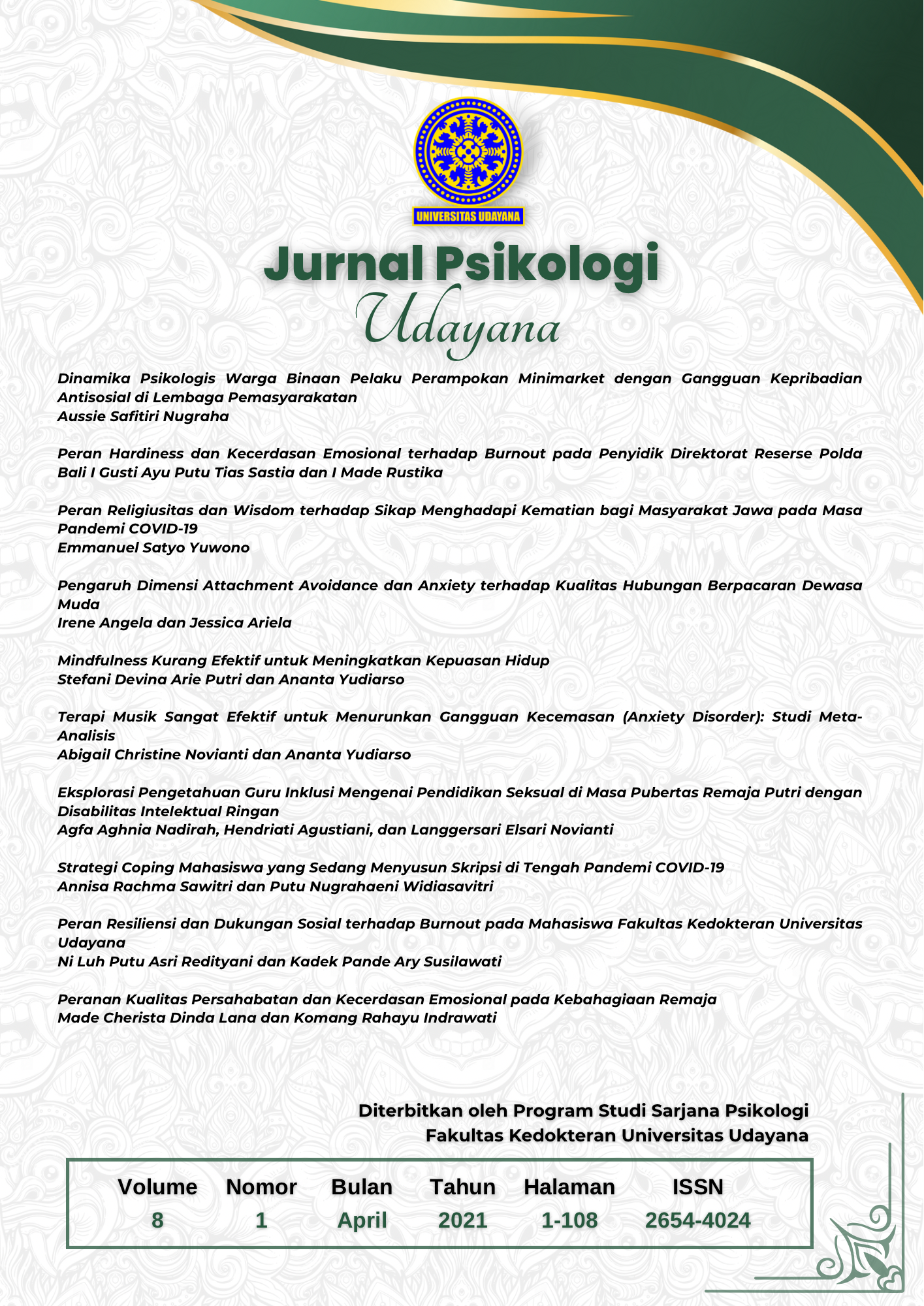Dinamika psikologis warga binaan pelaku perampokan minimarket dengan gangguan kepribadian antisosial di lembaga pemasyarakatan
Abstract
Perampokan merupakan salah satu tindakan kriminal yang ada di Indonesia. Pada umumnya, para pelaku membawa alat benda yang dapat menjadi senjata, seperti pisau atau celurit ketika melakukan aksi perampokan tersebut. Setiap tindakan kriminal tentu disertai oleh berbagai faktor yang melatarbelakangi pelaku yang dalam hal ini melakukan perampokan di minimarket. Adapun tujuan penelitian ini dilakukan untuk mengetahui dinamika psikologis yang dimiliki Abu (nama samaran), seorang warga binaan yang sedang menjalani masa hukuman di sebuah lembaga pemasyarakatan karena beberapa kali melakukan aksi perampokan pada tahun 2015. Teknik pengambilan data pada penelitian ini dilakukan dengan wawancara, observasi dan menggunakan rangkaian asesmen psikologi, meliputi Wechsler-Bellevue Intelligence Scale (WBIS), tes grafis (DAP, BAUM, dan HTP), SSCT (Sack’s Sentence Completion Test), dan Hare Self-Report Psychopathy Scale. Hasil asesmen menunjukkan bahwa Abu mengalami gangguan kepribadian antisosial yang ditegakkan berdasarkan kriteria pada DSM-5. Sementara itu, faktor utama yang mendorong Abu dalam melakukan aksi perampokan adalah karena kesulitan ekonomi dan permasalahan terkait self-control.
Downloads
References
Andrews, D.A., Bonta, J., & Wormith, J. S. (2006). The recent past and near future of risk and/or need assessment. Crime and Delinquency. https://doi.org/10.1177/0011128705281756.
Baron, S. W. (2003). Self-control, social consequences, and criminal behavior: Street youth and the general theory of crime. Journal of Research in Crime and Delinquency, 40(4), 403-425. https://doi.org/10.1177/0022427803256071.
Baumeister, R. F., & Lobbestael, J. (2011). Emotions and antisocial behavior. Journal of Forensic Psychiatry & Psychology, 22(5), 635-649.
https://doi.org/10.1080/14789949.2011.617535.
Bierer, L. M., Yehuda, R., Schmeidler, J., Mitropoulou, V., New, A. S., Silverman, J. M., & Siever, L. J. (2003). Abuse and neglect in childhood: Relationship to personality disorder. CNS Spectrums, 8(10), 737-754. https://doi.org/10.1017/s1092852900019118.
Dargis, M., Newman, J., & Koenigs, M. (2016). Clarifying the link between childhood abuse history and psychopathic traits in adult criminal offenders. Personality Disorders: Theory, Research, and Treatment, 7(3), 221-228. https://doi.org/10.1037/per0000147.
Emmelkamp, P. M. G., & Kamphuis, J. H. (2007). Personality disorders. New York: Psychology Press/Taylor & Francis. https://doi.org/10.4324/9781315824406.
Glenn, A. L., Johnson, A. K., & Raine, A. (2013, December). Antisocial personality disorder: A current review. Current Psychiatry Reports. https://doi.org/10.1007/s11920-013-0427-7.
Krastins, A., Francis, A. J. P., Field, A. M., & Carr, S. N. (2014). Childhood predictors of adulthood antisocial personality disorder symptomatology. Australian Psychologist, 49(3), 142-150. https://doi.org/10.1111/ap.12048.
Maass, V. S. (2019). Personality disorders: Elements, history, examples, and research. California: Praeger
Martin, S., Zabala, C., Del-Monte, J., Graziani, P., Aizpurua, E., Barry, T. J., & Ricarte, J. (2019, November). Examining the relationships between impulsivity, aggression, and recidivism for prisoners with antisocial personality disorder. Aggression and Violent Behavior. Elsevier Ltd. https://doi.org/10.1016/j.avb.2019.07.009.
Matejkowski, J. (2017). The moderating effects of antisocial personality disorder on the relationship between serious mental illness and types of prison infractions. Prison Journal, 97(2), 202-223. https://doi.org/10.1177/0032885517692804.
Moran, P. (1999, May). The epidemiology of antisocial personality disorder. Social Psychiatry and Psychiatric Epidemiology. https://doi.org/10.1007/s001270050138.
Morrison, G. M., Robertson, L., Laurie, B., & Kelly, J. (2002). Protective factors related to antisocial behavior trajectories. Journal of Clinical Psychology, 58(3), 277-290. https://doi.org/10.1002/jclp.10022.
Pfiffner, L. J., McBurnett, K., & Rathouz, P. J. (2001). Father absence and familial antisocial characteristics. Journal of Abnormal Child Psychology, 29(5), 357-367. https://doi.org/10.1023/A:1010421301435
Sa, M. (2015). Mood and personality disorders. Mood and personality disorders. Dalam G. M. Kapalka (Ed.), Treating disruptive disorders: A guide to psychological, pharmacological, and combined therapies (pp207-238). New York: Routledge.
Semple, D., & Smyth, R. (2009). Oxford handbook of psychiatry. New York: Oxford University Press. https://doi.org/10.1093/med/9780199239467.001/0001.
Sigelman, C. K., & Rider, E. A. (2009). Life-span human development (6th Edition). Belmont, CA: Wadsworth Cengage Learning.
van Koppen, M. V. (2018). Criminal career dimensions of juvenile and adult-onset offenders. Journal of Developmental and Life-Course Criminology, 4(1), 92-119. https://doi.org/10.1007/s40865-017-0074-5.
Vieno, A., Nation, M., Pastore, M., & Santinello, M. (2009). Parenting and antisocial behavior: A model of the relationship between adolescent self-disclosure, parental closeness, parental control, and adolescent antisocial behavior. Developmental Psychology, 45(6), 1509-1519. Doi: 10.1037/a0016929
Wesseldijk, L. W., Bartels, M., Vink, J. M., van Beijsterveldt, C. E. M., Ligthart, L., Boomsma, D. I., & Middeldorp, C. M. (2018). Genetic and environmenal influences on conduct and antisocial personality problems in childhood, adolescence, and adulthood. Eureopean Child and Adolescent Psychiatry, 27(9), 112301132. https://doi.org/10.1007/s00787-017-1014-y.

This work is licensed under a Creative Commons Attribution-ShareAlike 4.0 International License.
Authors who publish with this journal agree to the following terms:
- Authors retain copyright and grant the journal right of first publication with the work simultaneously licensed under a Creative Commons Attribution-ShareAlike 4.0 International License that allows others to share the work with an acknowledgement of the works authorship and initial publication in this journal.
- Authors are able to enter into separate, additional contractual arrangements for the non-exclusive distribution of the journals published version of the work (e.g., post it to an institutional repository or publish it in a book), with an acknowledgement of its initial publication in this journal.
- Authors are permitted and encouraged to post their work online (e.g., in institutional repositories or on their website) prior to and during the submission process, as it can lead to productive exchanges, as well as earlier and greater citation of published work (See The Effect of Open Access).













